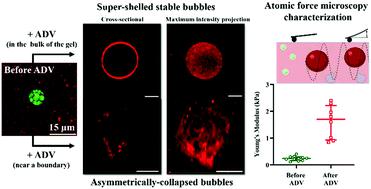当前位置:
X-MOL 学术
›
Soft Matter
›
论文详情
Our official English website, www.x-mol.net, welcomes your
feedback! (Note: you will need to create a separate account there.)
Spatiotemporal control of micromechanics and microstructure in acoustically-responsive scaffolds using acoustic droplet vaporization.
Soft Matter ( IF 2.9 ) Pub Date : 2020-06-23 , DOI: 10.1039/d0sm00753f Mitra Aliabouzar 1 , Christopher D Davidson 2 , William Y Wang 2 , Oliver D Kripfgans 3 , Renny T Franceschi 4 , Andrew J Putnam 2 , J Brian Fowlkes 3 , Brendon M Baker 2 , Mario L Fabiilli 3
Soft Matter ( IF 2.9 ) Pub Date : 2020-06-23 , DOI: 10.1039/d0sm00753f Mitra Aliabouzar 1 , Christopher D Davidson 2 , William Y Wang 2 , Oliver D Kripfgans 3 , Renny T Franceschi 4 , Andrew J Putnam 2 , J Brian Fowlkes 3 , Brendon M Baker 2 , Mario L Fabiilli 3
Affiliation

|
Acoustically-responsive scaffolds (ARSs), which are composite fibrin hydrogels, have been used to deliver regenerative molecules. ARSs respond to ultrasound in an on-demand, spatiotemporally-controlled manner via a mechanism termed acoustic droplet vaporization (ADV). Here, we study the ADV-induced, time-dependent micromechanical and microstructural changes to the fibrin matrix in ARSs using confocal fluorescence microscopy as well as atomic force microscopy. ARSs, containing phase-shift double emulsion (PSDE, mean diameter: 6.3 μm), were exposed to focused ultrasound to generate ADV – the phase transitioning of the PSDE into gas bubbles. As a result of ADV-induced mechanical strain, localized restructuring of fibrin occurred at the bubble–fibrin interface, leading to formation of locally denser regions. ADV-generated bubbles significantly reduced fibrin pore size and quantity within the ARS. Two types of ADV-generated bubble responses were observed in ARSs: super-shelled spherical bubbles, with a growth rate of 31 μm per day in diameter, as well as fluid-filled macropores, possibly as a result of acoustically-driven microjetting. Due to the strain stiffening behavior of fibrin, ADV induced a 4-fold increase in stiffness in regions of the ARS proximal to the ADV-generated bubble versus distal regions. These results highlight that the mechanical and structural microenvironment within an ARS can be spatiotemporally modulated using ultrasound, which could be used to control cellular processes and further the understanding of ADV-triggered drug delivery for regenerative applications.
中文翻译:

使用声液滴汽化对声响应支架中的微力学和微结构进行时空控制。
声响应支架(ARS)是复合纤维蛋白水凝胶,已被用来传递再生分子。 ARS通过一种称为声学液滴汽化 (ADV) 的机制,以按需、时空控制的方式响应超声波。在这里,我们使用共焦荧光显微镜和原子力显微镜研究了 ADV 诱导的、ARS 中纤维蛋白基质随时间变化的微机械和微结构变化。将含有相移双乳液(PSDE,平均直径:6.3 μm)的 ARS 暴露于聚焦超声下以产生 ADV——PSDE 相变为气泡。由于 ADV 诱导的机械应变,纤维蛋白在气泡-纤维蛋白界面处发生局部重组,导致局部致密区域的形成。 ADV 产生的气泡显着减少了 ARS 内的纤维蛋白孔径和数量。在 ARS 中观察到两种类型的 ADV 产生的气泡反应:超壳球形气泡,直径每天增长 31 μm,以及充满液体的大孔,可能是声驱动微喷射的结果。由于纤维蛋白的应变硬化行为,ADV 导致 ADV 生成的气泡近端 ARS 区域的硬度比远端区域增加 4 倍。这些结果强调,ARS 内的机械和结构微环境可以使用超声波进行时空调节,这可用于控制细胞过程并进一步了解 ADV 触发的药物输送用于再生应用。
更新日期:2020-07-22
中文翻译:

使用声液滴汽化对声响应支架中的微力学和微结构进行时空控制。
声响应支架(ARS)是复合纤维蛋白水凝胶,已被用来传递再生分子。 ARS通过一种称为声学液滴汽化 (ADV) 的机制,以按需、时空控制的方式响应超声波。在这里,我们使用共焦荧光显微镜和原子力显微镜研究了 ADV 诱导的、ARS 中纤维蛋白基质随时间变化的微机械和微结构变化。将含有相移双乳液(PSDE,平均直径:6.3 μm)的 ARS 暴露于聚焦超声下以产生 ADV——PSDE 相变为气泡。由于 ADV 诱导的机械应变,纤维蛋白在气泡-纤维蛋白界面处发生局部重组,导致局部致密区域的形成。 ADV 产生的气泡显着减少了 ARS 内的纤维蛋白孔径和数量。在 ARS 中观察到两种类型的 ADV 产生的气泡反应:超壳球形气泡,直径每天增长 31 μm,以及充满液体的大孔,可能是声驱动微喷射的结果。由于纤维蛋白的应变硬化行为,ADV 导致 ADV 生成的气泡近端 ARS 区域的硬度比远端区域增加 4 倍。这些结果强调,ARS 内的机械和结构微环境可以使用超声波进行时空调节,这可用于控制细胞过程并进一步了解 ADV 触发的药物输送用于再生应用。











































 京公网安备 11010802027423号
京公网安备 11010802027423号